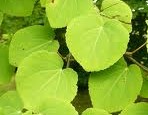 This large deciduous tree native to Japan and China is usually grown for its very attractive foliage. As the generic name, Cercidiphyllum, implies the leaves resemble those of redbud, in the genus Ceris. Oval to heart-shaped, the leaves emerge reddish purple in spring and mature to blue-green in summer before turning yellow, orange, or red in the fall. The autumn display is heightened by an aromatic scent produced by the leaves as they change color. The aromas are described as burnt sugar, cinnamon, ripe apples, and ginger treacle pudding. Inconspicuous male and female flowers are produced on different trees in early spring before the leaves emerge and pollinated female flowers produce small greenish pods containing winged seeds. The brown bark of mature trees is shaggy and exfoliates. Trees are attractive in woodland settings, parks and other open spaces, or can be used as street trees. They are especially pleasing in waterside plantings where they can enjoy the moisture. Locate in their permanent spot because the plants are difficult to transplant. Dwarf and weeping cultivars are available.
This large deciduous tree native to Japan and China is usually grown for its very attractive foliage. As the generic name, Cercidiphyllum, implies the leaves resemble those of redbud, in the genus Ceris. Oval to heart-shaped, the leaves emerge reddish purple in spring and mature to blue-green in summer before turning yellow, orange, or red in the fall. The autumn display is heightened by an aromatic scent produced by the leaves as they change color. The aromas are described as burnt sugar, cinnamon, ripe apples, and ginger treacle pudding. Inconspicuous male and female flowers are produced on different trees in early spring before the leaves emerge and pollinated female flowers produce small greenish pods containing winged seeds. The brown bark of mature trees is shaggy and exfoliates. Trees are attractive in woodland settings, parks and other open spaces, or can be used as street trees. They are especially pleasing in waterside plantings where they can enjoy the moisture. Locate in their permanent spot because the plants are difficult to transplant. Dwarf and weeping cultivars are available.
Type: Deciduous tree
Outstanding Features: Foliage, especially in autumn
Form: Pyramidal or spreading; dense crown
Growth Rate: Medium
Bloom: Inconspicuous male and female flowers are produced in early spring before the leaves appear.
Size: 40-60’ H x 20-40’ W
Light: Full sun to partial shade
Soil: Fertile, moist, well-drained
Hardiness: Zones 4-8
Care: Low maintenance
Pests and Diseases: Generally pest and disease free
Propagation: Seed, basal or semi-hardwood cuttings
Outstanding Selections:
 ‘Heronswood Globe’ (15’ tall)
‘Heronswood Globe’ (15’ tall) ‘Pendula’ (weeping)
‘Pendula’ (weeping)